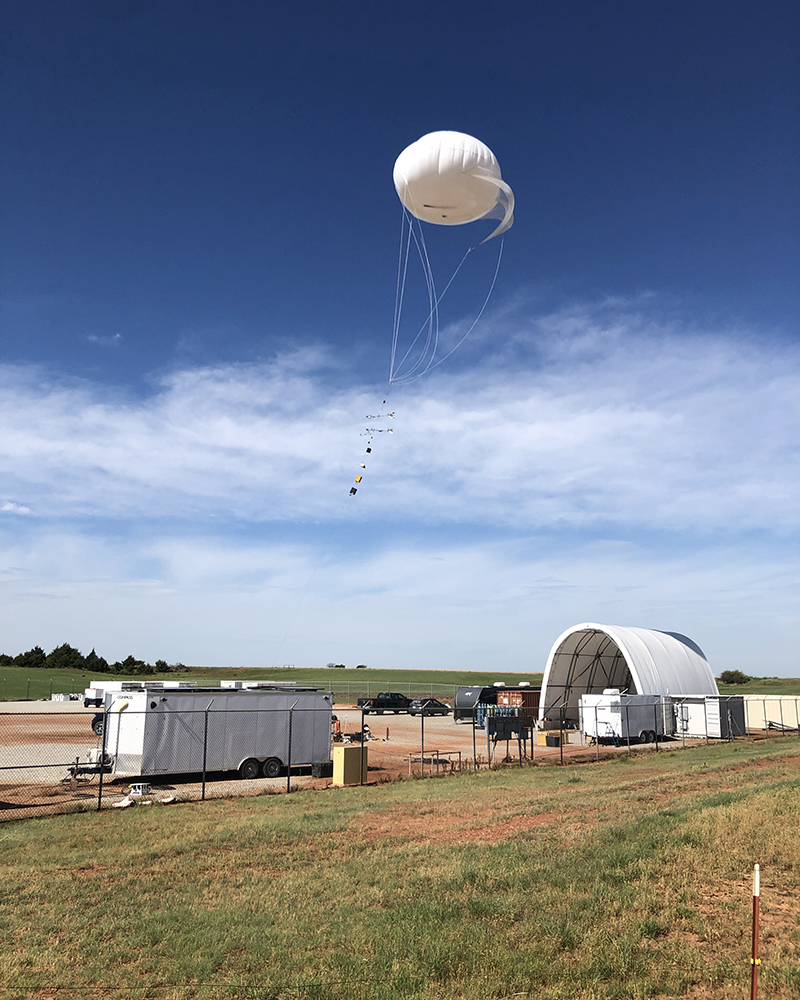5 new campaigns approved from 2 separate calls

In fiscal year 2025, the Atmospheric Radiation Measurement (ARM) user facility plans to conduct tethered balloon system (TBS) flights in Alabama, Maryland, and Oklahoma.
Five newly approved field campaigns are designed to rely on data from those flights.
Three of the campaigns will integrate capabilities of ARM and another U.S. Department of Energy (DOE) Office of Science user facility, the Environmental Molecular Sciences Laboratory (EMSL). The campaigns were proposed during an ARM/EMSL call for collaborative research applications through the Facilities Integrating Collaborations for User Science (FICUS) program. The FICUS program aims to enable ambitious research by providing access to specialized expertise and instrumentation from multiple user facilities.
Through the ARM/EMSL FICUS call, researchers could apply to use EMSL instruments to collect samples of aerosols and volatile organic compounds on ARM TBS flights and then conduct analysis using advanced laboratory techniques at EMSL.
At the same time as the ARM/EMSL FICUS call, ARM held a separate non-FICUS call for TBS proposals that did not require EMSL resources. Two of the five newly approved TBS campaigns are from the ARM-only call.
Descriptions of the FICUS and non-FICUS campaigns are below, and look for information coming this winter about new FICUS/TBS calls.
ARM/EMSL FICUS Campaigns
Daniel Knopf, Stony Brook University
Acquiring Vertical Profiles of Aerosol and Ice-Nucleating Particles for Aerosol-Ice Formation Closure

Atmospheric ice formation is considered a significant challenge in atmospheric sciences because of the lack of understanding of how aerosols acting as ice-nucleating particles cause ice crystal formation.
Knopf and his multi-institutional team plan to use particle samples collected at different altitudes at two ARM atmospheric observatories—the Bankhead National Forest (BNF) in northwestern Alabama and the Southern Great Plains (SGP) in north‑central Oklahoma—to assess the predictive understanding of ice formation to benefit cloud and climate models.
Researchers will use EMSL’s microspectroscopic analytical techniques to characterize the physicochemical properties of individual ice-nucleating particles and to determine the corresponding freezing rates.
Chongai Kuang, Brookhaven National Laboratory
Quantifying the Integrated Terrestrial Controls on Aerosol Sources, Transformations, and Climate Impacts in the Southeastern United States

A team of researchers, led by Kuang, is studying how land influences particle sources and movement in the atmospheric boundary layer above forests. Using BNF data, the team plans to examine how biological aerosols and biogenic volatile organic compounds are vertically distributed in the atmosphere and how those distributions change with the seasons. These investigations will shed light on how forests affect the dynamics of atmospheric particles.
Measurements taken will be combined with surface and tower observations in a detailed model to understand how land-atmosphere interactions control airborne particles.
EMSL’s aerosol capabilities, including nanospray desorption electrospray ionization, focused ion beam-scanning electron microscopy, and size- and time-resolved aerosol collection, will be used to help analyze the collected particle samples.
Jason Surratt, University of North Carolina at Chapel Hill
Chemical Characterization of Secondary Organic Aerosol from Isoprene-Derived Epoxydiols with Altitude at the DOE ARM Bankhead National Forest (BNF) Site During Spring and Summer 2025

Surratt is leading a project looking at how varied altitude affects the composition of secondary organic aerosol, particularly from the acid-driven multiphase chemistry of isoprene-derived epoxydiols (IEPOX), which are intermediate products in the conversion of isoprene (gas phase) to secondary organic aerosol (particle phase).
Project plans include collecting aerosol samples at different altitudes in spring and summer 2025 using EMSL’s Size and Time-resolved Aerosol Collector (STAC) onboard the ARM TBS at the BNF. EMSL’s Time-Resolved Automated Volatile organic compounds Sampling (TRAVIS) platform will be deployed to analyze volatile organic compounds, and EMSL microscopy and mass spectrometry will be used to characterize aerosol composition and physiochemical properties. This research is designed to improve mechanistic representations of IEPOX-derived secondary organic aerosol within earth system models.
Read the initial announcement of fiscal year 2025 FICUS projects on EMSL’s website.
ARM Non-FICUS Campaigns
Swarup China, Pacific Northwest National Laboratory
Bioaerosol in the Bankhead National Forest

Naturally occurring particles known as bioaerosols (e.g., pollen, fungal spores, bacteria, and plant debris) affect Earth’s climate and water cycles by serving as nuclei for cloud droplets and ice crystals. The BNF is an ideal site to study bioaerosols because it sits in a forested region.
China and his team seek to improve understanding of the role that bioaerosols play in cloud ice formation. They also want to learn more about the radiative impacts of such particles. Their work will combine field measurements, laboratory experiments, and modeling techniques.
At the BNF, scientists plan to deploy a newly developed Mini-STAC onboard the ARM TBS to collect samples of size-resolved and total suspended aerosol in the atmosphere. China’s team also intends to deploy a Mini-Time-resolved Bulk Aerosol Collector (Mini-TBAC). Samples from the Mini-TBAC and Mini-STAC will provide comprehensive analysis of bioaerosols and their ice formation potential around the BNF.
Jie Zhang and Fangqun Yu, University at Albany
Seasonal/Spatial Vertical NPF Variation Study

New particle formation (NPF) is one of the largest sources of atmospheric aerosols, and it significantly contributes to the formation of cloud condensation nuclei. To fully grasp the role of NPF in climate dynamics, scientists seek more data on NPF events at and above ground level, in various environments and atmospheric conditions.
Zhang and Yu’s team wants to study the mechanisms behind the vertical and spatial extent of NPF and its growth, the effects of NPF on cloud condensation nuclei, and how such effects and mechanisms can vary across a large region, such as the eastern United States. To do this, the team plans to combine TBS and ground-based measurements from the BNF and the Coast-Urban-Rural Atmospheric Gradient Experiment (CoURAGE) in the Baltimore, Maryland, area with three-dimensional (3D) modeling.
Findings from the campaign could help reduce uncertainties in the radiative effects of aerosols on climate and improve understanding of aerosol processes that affect the Earth’s energy balance and water cycle.
Scientist photos are courtesy of the researchers and their institutions.
# # #ARM is a DOE Office of Science user facility operated by nine DOE national laboratories.

